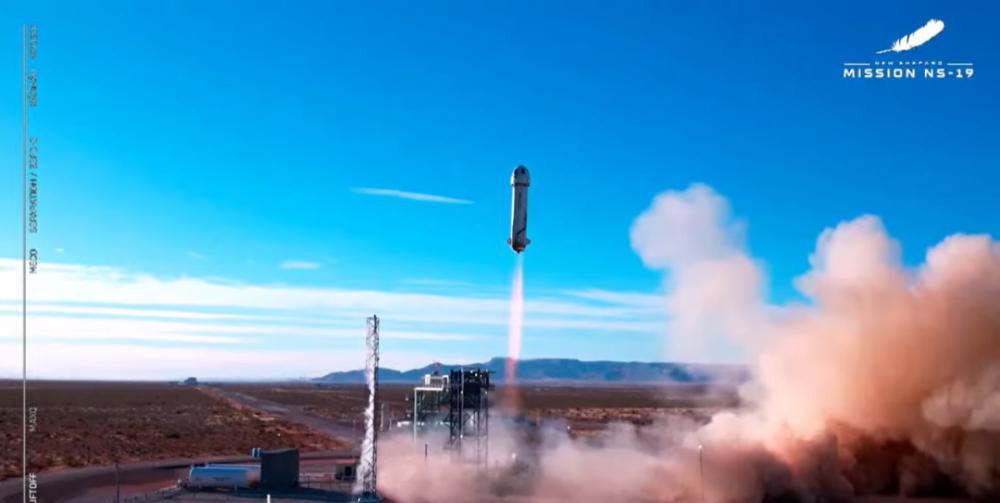On December 11, local time, Blue Origin completed its third manned mission and successfully sent six astronauts into space.
The mission, code-named NS-19, was launched at the Launch Site One launch site in Texas and was still carried out by New Shepard rockets.

Figure | New Shepard Rocket Mission NS-19 (Source: Blue Origin)
It is understood that the launch reached an altitude of more than 100 kilometers. From launch to return, the mission lasted about 11 minutes, and the crew experienced about 3 minutes of weightlessness.
Here are a few specific data: mission duration 10 minutes and 13 seconds, maximum ascent speed of 3611 km/h, boosters reaching an apogee of 105.8 km above ground, and crew cabins reaching an apogee of 105.9 km above ground.
Figure | NS-19 Mission Crew Cabin Landing (Source: Blue Origin)
It is worth mentioning that the number of crews of the NS-19 has exceeded the previous one, and the number of launches in the first two times was 4 people, and this time it reached 6 people.
Among the 6 people, there are four paying customers: Aerospace industry executive and philanthropist Dylan Taylor, investor Evan Dick, Bess Ventures founder Lane Bess and Cameron Bess. Among them, Ryan Beth and Cameron Bess are parent-child relationships, and they are also the first father and son to fly in space.
The other two were invited guests, one was Michael Strahan, co-anchor of Good Morning America; the other was Laura Shepard Churchley, the eldest daughter of Alan Shepard, the first American to fly into space, and the New Shepard rocket was named after Alan Shepard. Alan Shepard was also the fifth person to walk on the moon.
Figure | Six crew members of the NS-19 (Source: Blue Origin)
Churchley currently chairs the Board of Trustees of the Astronaut Scholarship Foundation, which aims to raise money for college students and provide guidance to academics pursuing STEM careers and research.
Strahan is a two-time Emmy Award winner and Super Bowl champion, and in addition to being a co-anchor of Good Morning America, he is also a co-founder of SMAC Entertainment.
Taylor is chairman and CEO of Voyager Space, a global space exploration company, and founder of Space for Humanity, a global nonprofit organization that democratizes access to space.
Dick is an engineer, investor and management member of Dick Holdings LLC. He is also an ATP-class pilot and an avid sailor and motorcyclist.
Ryan Beth is the head and founder of Bess Ventures and Advisory, a family-owned fund that supports companies that innovate and disrupt in multiple market sectors.
Cameron Bass is a content creator who graduated from the DigiPen Institute of Technology in Washington State, where he studied computer science and game design.
According to Blue Origin, crews only need to receive just two days of training to perform flight missions. Crew members experience missions such as weightlessness in a capsule simulator and learn everything they need to fly in space.
"The New Shepard rocket has been launched six times this year, sending 14 astronauts into space and testing payloads such as NASA's lunar landing sensors." Bob Smith, CEO of Blue Origin, said, "I'm proud to be part of this dedicated and hard-working team. ”
However, it is worth noting that the three manned missions of Blue Origin lasted about 11 minutes and reached altitudes of less than 110 kilometers. This is still a bit of a gap from spaceX, which it often compares with Elon Musk.
SpaceX's most recent manned mission was to send four astronauts to the International Space Station (ISS), which is more than 400 kilometers high, and its first all-private space mission, Inspiration 4, which was conducted in September, reached an altitude of 575 kilometers, surpassing not only the ISS but also 540 kilometers above the Hubble Space Telescope. In terms of time, the four members of Inspiration 4 spent three days in space.
Figure | Inspiration 4 mission altitude (Source: SpaceX)
One of the big differences between Blue Origin and SpaceX's manned missions is the rocket system used to launch.
It is understood that Blue Origin's New Shepard is a suborbital space flight rocket designed to carry astronauts and payloads across the Carmen line (the internationally recognized space boundary, 100 kilometers above the ground), and the mission time is only about 11 minutes.
The New Shepard Booster has been designed to have more than 25 launches and has been launched 19 times, including three escape tests. "The escape test verified that the crew escape system could be safely activated at any stage of the flight."
SpaceX typically operates the Falcon 9, which is "the world's first orbital-stage reusable rocket."
Blue Origin is underway to develop the orbital-stage launch vehicle New Glenn, which is "capable of regularly transporting people and payloads to Earth's orbit and beyond."
Finally, Blue Origin says it will also conduct several manned and payload missions in 2022.
-End-
reference:
https://www.blueorigin.com/news/new-shepard-ns-19-mission-updates
https://www.blueorigin.com/news/new-shepard-ns-19-mission-announcement